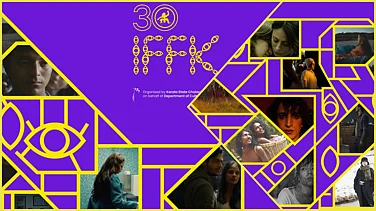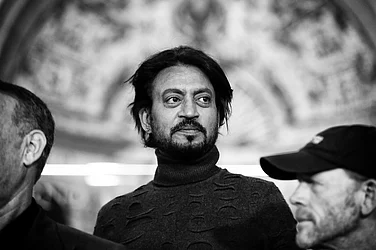“To become public is to be seen and accounted for in history,” announces the text on the white walls introducing the photography exhibition at Pepper House, an art space cafe in Kochi where the Biennale is currently on. The sentence sounded revolutionary, hinting at an alternative history project. Is it a cry for a battle against the systematic invisibilisation of certain peoples, and of women?
Right next to the text hangs a framed colour photograph of a women’s public gathering in 1981 in Nepal. Next to that are some personal frames involving women—their portraits at home and in studios, indoor and outdoor group photos and other usual travel pictures. A few steps away are the more action-packed ones—women addressing political rallies and public gatherings, taking part in the Maoist armed revolution. It’s a room full of Nepali women’s photos of many sizes, some framed, some not; some in colour and some black and white; some on the walls, some pinned up on white wooden tables. “The journey of Nepali women from within the boundaries of domesticity to the openness of public life is a move from obscurity to memory,” the text on the wall further declares.
It all sounds like Czech novelist Milan Kundera’s famous utterance in The Book of Laughter and Forgetting—“The struggle of man against power is the struggle of memory against forgetting.” Except that, in this case, we need to modify the sentence, with some apology to the novelist, to: ‘The struggle of woman against the power of man is the struggle of memory against forgetting.’
For centuries, writing, erasing and rewriting histories have been a part of human intellectual exercise at individual, group and institutional levels. But just as it is said that history is written by the victors, human history has been written overwhelmingly by men and they have written about men and their glory and agony, mentioning women mostly in passing, or as just another object of man’s possession or accompaniment.
Pictures carry moments frozen in frames—some of them historic, some just the mundane, the insignificant, and some amazing. But they all do serve one purpose of preserving lost time, place and people. In The Book of Laughter and Forgetting, Kundera weaves a whole segment depicting fear, courage, surveillance, hypocrisy and suppression around multiple versions of one group photo—from which the ‘fallen’ persons kept vanishing as the years passed. But the hat on the head of the last standing man in the photo, Klement Gottwald, belonged to one of his comrades who had been erased. Vladimir Clematis continues to exist because the picture has his hat on Gottwald’s head.
The exhibition at Pepper House as a part of the Kochi-Muziris Biennale is, therefore, a landmark work. Titled ‘The Public Life of Women: A Feminist Memory Project’, it “rides on the feminist impulse to memorialise women’s pasts in the belief that their historic visibility will advance the cause of liberation,” according to the curators. It explores “the ways women made new positions and new subjectivities possible through their entry into popular politics and public life.”
It’s a project of the Kathmandu-based Nepal Picture Library, an independent digital photography archive whose collection comprises over 1,20,000 photographs acquired from individual and institutional sources across the country, a large number of them through crowdsourcing. Since the first show at Patan Durbar Square in 2018, the exhibition curated by Nayantara Kakshapati and Dewas Raja KC has travelled to many parts of the world. In the words of the curators, it “proposes archiving as an act of imagining futures for feminism in Nepal and beyond.” It is necessary to know how the past looked like to imagine the future, and especially for women—the past has been a dark alley.
The selection at the Kochi-Muziris Biennale includes a photo from 1947, showing a group of saree-clad women standing, some of them with babies on their laps, and some with children sitting in front of them. The accompanying caption says those in the photo were part of the Nepal Women’s Association that was formed to support the democratic movement against the Rana dynasty.
A 1964 photo shows meritorious student Gomati Shreshtha tutoring children at home. A 1966 photo shows villagers gathering to bid farewell to women travelling to Kathmandu for higher education, a journey of 800 km that back then required two weeks to traverse. There are photos of Tharu women who led the 1980 rebellion against tyrant landlords in the Karjahi area of Dang district. There is the cover image of the ground-breaking research volume titled Status of Women in Nepal that was published sometime between 1979 and 1981. It is accompanied by photos showing researcher Indira Shrestha with Tamang women while conducting this research. In one 1983 photo, educationist Sudha Tripathi is seen posing for a Kodak camera, which she had just bought with her own salary, dressed in men’s traditional Nepali attire. Is it a statement she is making?
There are other objects, too. For example, a handwritten letter from Nepali politician and architect Hisila Yami, to her daughter, penned when Yami lived an underground life as a participant in the Maoist party’s guerrilla movement. Yami’s husband, Baburam Bhattarai, became Nepal’s prime minister in 2011, three years after the Maoist party came overground with the end of constitutional monarchy. Another photo and the accompanying caption depicts how, after the revolution ended in 2008, the women Maoist fighters got busy focussing on ‘re-integrating with the society’, while men took hold of electoral politics.
Memory is the lane that takes us to our roots. And one must know her roots before she knows what all belonged to her. And for her to reclaim what was truly hers, she needs not one, but many such feminist memory projects.
(This appeared in the print edition as "Memory Project of Women")


























